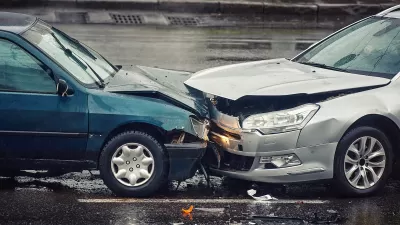Sarah Goodyear describes the greater implications of the carnage caused by a motorist intent on mowing down as many pedestrians as possible on the Venice boardwalk in L.A. on August 03. It wasn't the first time a car caused mayhem in a public space.
The suspect, Nathan Louis Campbell, "allegedly used his car as a weapon". He had driven his car "at an estimated 60 miles per hour through a crowded pedestrian area in the beachfront community, killing one woman and injuring another 11. Witnesses said he appeared to be zigzagging in order to hit as many people as possible."
According to the Los Angeles Times, Campbell, "who was arraigned Tuesday (August 06) afternoon, faces 16 counts of assault with a deadly weapon and 17 counts of hit-and-run, according to the Los Angeles County District Attorney's Office."
He is also charged with murder in the death of Alice Gruppioni, 32, of Italy, who was in Los Angeles on her honeymoon. At least 16 others were injured.
Goodyear contrasts this incident with "the last time that a car invaded pedestrian space in this part of the world – in 2003, when an elderly driver rammed into the Santa Monica Farmers’ Market, killing 10 and injuring 70."
That time was different from this one – it was what people like to call an "accident". The driver, an 86-year-old man, apparently became confused and accelerated into the crowd.
Or was it different? The LA Times article notes that it is being called a "horrible accident" by the public defender.
"I don't believe he intentionally tried to hit anybody," said public defender Philip Dube told the Associated Press. "He's profoundly sad, he is profoundly depressed, that he has potentially ended somebody's life. I think this was a horrible accident."
Goodyear references the 2008 book, Driven to Kill, by J. Peter Rothe, an associate professor at the University of Alberta, that may explain our tendency to label all auto incidents as "accidents", even when they result "when people drive aggressively or vengefully".
On August 11, 1997, the U.S. Department of Transportation’s National Highway Traffic Safety Administration launched a campaign, “Crashes are Not Accidents", to change the thinking about traffic crashes by expunging "accidents" from their terminology. Goodyear wrote on March 11 that "the (New York Police Department) is now replacing the term “accident" with the word “collision."
FULL STORY: When a Car Becomes a Weapon

Maui's Vacation Rental Debate Turns Ugly
Verbal attacks, misinformation campaigns and fistfights plague a high-stakes debate to convert thousands of vacation rentals into long-term housing.

Planetizen Federal Action Tracker
A weekly monitor of how Trump’s orders and actions are impacting planners and planning in America.

Chicago’s Ghost Rails
Just beneath the surface of the modern city lie the remnants of its expansive early 20th-century streetcar system.

Bend, Oregon Zoning Reforms Prioritize Small-Scale Housing
The city altered its zoning code to allow multi-family housing and eliminated parking mandates citywide.

Amtrak Cutting Jobs, Funding to High-Speed Rail
The agency plans to cut 10 percent of its workforce and has confirmed it will not fund new high-speed rail projects.

LA Denies Basic Services to Unhoused Residents
The city has repeatedly failed to respond to requests for trash pickup at encampment sites, and eliminated a program that provided mobile showers and toilets.
Urban Design for Planners 1: Software Tools
This six-course series explores essential urban design concepts using open source software and equips planners with the tools they need to participate fully in the urban design process.
Planning for Universal Design
Learn the tools for implementing Universal Design in planning regulations.
planning NEXT
Appalachian Highlands Housing Partners
Mpact (founded as Rail~Volution)
City of Camden Redevelopment Agency
City of Astoria
City of Portland
City of Laramie



























